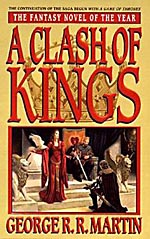
![]() verkisto
verkisto
7/26/2016
![]()
While reading A Game of Thrones, I mentioned to my wife how faithful the first season was to the book. Aside from following the main plots, subplots, subterfuge, and the like, it was also a perfectly cast show, in that the personalities portrayed by the actors perfectly matched those of the book. As I kept praising the show, she asked me, "Why read the book at all, then?"
It's a good question, and one that I had a hard time answering. There are certainly minor differences (Theon Greyjoy is introduced sooner, and more completely than he was in the book), some less important than others (it turns out that Jaime Lannister pushed Bran out of the window with his left hand in the book, but with his right hand in the show; is that somehow significant?), but it's not like Martin's prose is lyrical and poetic enough to justify reading through over 2000 pages to experience the story I already know. Much of the dialogue was taken verbatim from the book, and even the notable points not spoken aloud were somehow worked into the show.
As I started reading A Clash of Kings, the answer came to me. It's in how Martin structures the books. He tells the story from point-of-view characters, alternating through a handful of choice characters. In the first book, it was told through Ned, Arya, Jon, Daenerys, Bran, Tyrion, Sansa, and Caetlyn. We get insights into the characters through their chapters, but we also see parts of the story told about one of the POV characters through the eyes of another. We know Tyrion is the most honorable of all the Lannisters, but when Caetlyn arrests him, we see much of that through her eyes. We experience her distrust, frustration, and anger at him, even as we know he's not completely deserving of those feelings. Martin shifts the narrative around this way, giving us a more complete picture of all the principle characters, while notably not giving us a single chapter told from Joffrey's point of view. Martin establishes through the first two books that no character in the world of Westeros is as black or white as we would like to believe; why then aren't we given a better understanding of Joffrey? Neither do we see chapters from the points of view of Cersei, Tywin, or The Hound, so we're deprived of getting a fuller understanding of the primary antagonists. Is it merely storytelling convenience (we all have to have bad guys in our stories, and the Lannisters certainly suffice), or is there something more to it? Robb Stark is also curiously omitted from the chapters, so that we only see him through the eyes of his family. Is Martin telling us something about the world and human nature by structuring the story this way?
Martin continues to play with the readers' expectations by playing around with these conventions of standard storytelling. We get used to the idea of having our good guys and our bad guys, but this time around, Martin chooses to put the Lannisters in a sympathetic light through Stannis Baratheon's siege on King's Landing. We're supposed to want them to lose, right? I mean, we've seen the horrible things that Joffrey will do in A Game of Thrones (to say nothing of the atrocities he commits in A Clash of Kings); why then do we suddenly root for the family in this book? Joffrey still is as unsympathetic as a villain can be, without coming across as cartoonish, but Martin still portrays him as a young boy given massive amounts of power and no real restraint against it. At least with Cersei and Tywin, we can dislike them for their cold, calculating methods for grabbing and keeping power; with Joffrey, he's just a kid waving around his father's loaded handgun. Even in Joffrey's cruelest moments, Martin makes sure to remind us of that fact.
Ultimately, reading the books gives me a chance to experience the story over again, and that they're as gripping as the show tells me that I made the right choice.